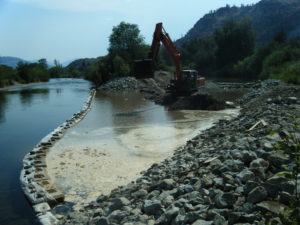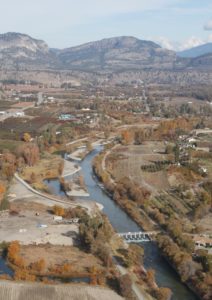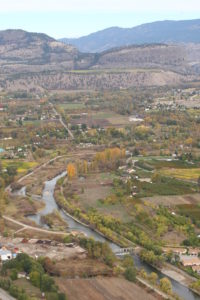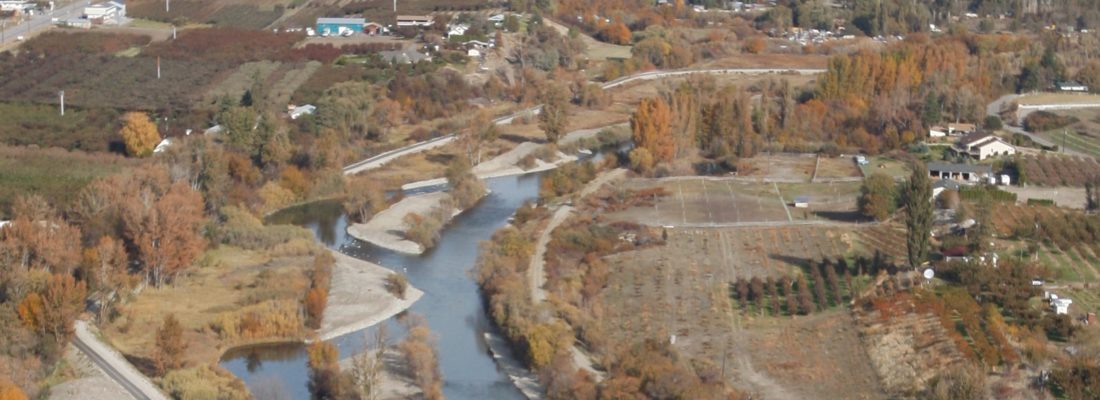Project Overview:
The health of the Okanagan River watershed has been severely impacted by the channelization that occurred in the mid-1950’s. Only 16% (4.9 km) of the river remains in a natural (2.8 km) or semi-natural state (2.1 km) and 84% (30.4 km) of the river has been channelized, straightened, narrowed and diked.
The ORRI concept was conceived in 2000 to return portions of the channelized Okanagan River back to a more natural condition and regain some of the lost habitat quality and quantity. The site is located in Oliver, approximately 17 km upstream of Osoyoos Lake, and was specifically chosen based on channel gradient and connection to upstream productive habitats. This project regains some of the lost habitat quality and quantity in a channelized section of the river by creating more complex and diverse habitat system.
ORRI follows an ecosystem based approach for the benefit of Indigenous aquatic and terrestrial species. It involves relocating dikes, lengthening the channel, re-establishing meanders and pool/riffle sequences, reconnecting the river to contiguous floodplains, creating side channels and replanting riparian vegetation. Highlights of 5-years monitoring of this project include the reactivation of the floodplain at high flows, riparian vegetation growth, reduction of invasive macrophyte species (milfloil), and increased use of the site by Sockeye Salmon, Rainbow Trout, Yellow Breasted Chat, and Great Basin Spadefoot Toad.
Project Goals:
The goal is to return portions of the channelized river back to more natural conditions. ORRI restoration works include:
- Relocating dikes and reconnecting the river to its historic floodplains.
- Re-establishing river meanders, lengthening the river channel and re-creating pool/riffle sequences.
- Creating nature-like habitat features, such as, spawning beds, rock riffles, side channels, wetland ponds, boulder clusters and gravel bars.
Main monitoring highlights:
- Desired spawning-flow Froude numbers achieved during construction remained within the range preferred by salmon even after natural sediment transport processes during subsequent freshets.
- Pool and riffle habitats continue to dominate the restoration area, and the channel configuration is self- sustaining for spawning salmon needs even though there has been bed-load movement, gravel bar creation, and pool depth changes.
- During the 2011 freshet, the newly connected ORRI floodplain was inundated with water for 3-4 weeks; observed in just over 1/3 of the floodplain area.
- The number of fish habitat features, such as large woody debris, increased from natural transport and was sustained.
- Total coverage of all macrophyte species was reduced, the proportion of introduced invasive macrophyte species was reduced, and native macrophyte species diversity increased.
- Pre-treatment, no salmonids were documented during snorkel surveys; however, post-treatment snorkel surveys documented Rainbow Trout in all years.
- Sockeye and Chinook have been using the restoration features (pools and spawning beds). The proportion of salmon spawners selecting Phase I increased over the reference reach, and continued increase over pre-treatment conditions for Phase I.
- Sockeye low egg-incubation survival drastically improved in Phase I post-treatment with survival rates similar to those measured in the natural reaches of the qa̓ wsitkw (Okanagan River).
- Successful planting and natural vegetation growth is occurring in the re-established floodplain.
- Key species at risk, like Yellow-breasted Chat and Great Basin Spadefoot have been using the re-established floodplain.
- Replanting riparian vegetation.
The long term purpose is to create more complex and diverse habitat for fish and wildlife (multi-species).
Project Plan:
ORRI phases (constructed to date):
- Phase I: Re-connection of two isolated oxbows and historic floodplain (Oliver, 2009).
- Phase II: Re-connection of a natural side channel (Oliver, 2013).
- VDS 13: Modifying a vertical drop structure to enhance upstream spawning habitat (Oliver, 2013).
- Floodplain features: Creation of ponds for amphibians in Phase I reconnected floodplain (Oliver, 2014).
- Beds No.1, 2 & 3: Creation of spawning beds for salmonids (Penticton, 2014 & 2015).
Project Documents:
Project Media:




